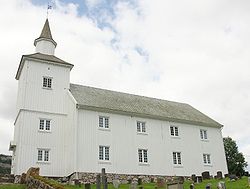
Sirdal is a municipality in Vest-Agder county, Norway. It is located in the northwestern part of the traditional district of Lister. The administrative centre of the municipality is the village of Tonstad. Other villages in Sirdal include Bjørnestad, Haughom, Kvæven, Lunde, and Tjørhom.

Bygland is a municipality in Aust-Agder county, Norway. It is located in the traditional district of Setesdal. The administrative centre of the municipality is the village of Bygland. Other villages in the municipality include Åraksbø, Austad, Byglandsfjord, Grendi, Langeid, Lauvdal, Litveit, Longerak, Moi, Ose, Sandnes, Skåmedal, and Tveit. The Norwegian National Road 9 runs through the municipality, following the river Otra where most of the population of Bygland lives.

Tonstad is the administrative centre of the municipality of Sirdal in Vest-Agder county, Norway. The village is located at the northern end of the lake Sirdalsvatnet in the Sirdalen valley. The 1.14-square-kilometre (280-acre) village has a population (2015) of 874, giving the village a population density of 767 inhabitants per square kilometre (1,990/sq mi).
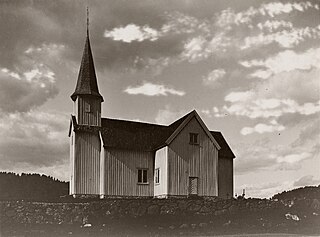
Finsland or Finnsland is a village in Songdalen municipality in Vest-Agder county, Norway. The village is located about 25 kilometres (16 mi) northwest of Nodeland and about 8 kilometres (5.0 mi) southeast of the village of Bjelland. The village is very small and it is located in a very rural area, but it is the site of Finsland Church, the main church for the northern half of Songdalen municipality. The village was the administrative centre of the old municipality of Finsland which existed from 1838 until its dissolution in 1964.

Kvifjorden is a lake in Norway that straddles the borders of the municipalities of Sirdal and Kvinesdal in Vest-Agder county and Bygland in Aust-Agder county. The lake was created when a dam was built along the Kvina river.

Vigmostad is a village in Lindesnes municipality in Vest-Agder county, Norway. The village is located along the Audna river in the Audnedalen valley. The village of Konsmo lies about 10 kilometres (6.2 mi) to the north and about 15 kilometres (9.3 mi) north of the village of Vigeland. Vigmostad Church is located in the village.

Laudal is a village in Marnardal municipality in Vest-Agder county, Norway. The village is located on the western shore of the Mandalselva river, about 15 kilometres (9.3 mi) south of the village of Bjelland and about 9 kilometres (5.6 mi) north of the village of Øyslebø. The village of Laudal has 191 residents (2001). Laudal was the administrative centre of the old municipality of Laudal which existed from 1899 until its dissolution in 1964. Laudal Church is located in the small village.

Vigeland is the administrative center of Lindesnes municipality in Vest-Agder county, Norway. The village is located along the river Audna, about 5 kilometres (3.1 mi) north of the river's mouth at the Snigsfjorden. The European route E39 highway runs east-west through Vigeland, connecting it to the town of Mandal, about 12 kilometres (7.5 mi) to the southeast. The 1.19-square-kilometre (290-acre) village has a population (2015) of 1,471 which gives the village a population density of 1,236 inhabitants per square kilometre (3,200/sq mi).

Gyland is a village in the municipality of Flekkefjord in Vest-Agder county in Norway. It is located in the northeastern part of Flekkefjord along the river Gylandselva, just a short distance north of the lake Kumlevollvatnet. The Sørlandet Line runs just south of the village, stopping at Gyland Station. The local village church, Gyland Church, was located in the village until 1929 when it was moved about 3 kilometres (1.9 mi) to the southwest. Now a small chapel is located in Gyland where the old church was once standing.
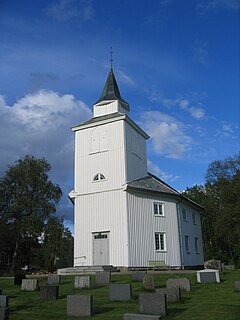
Øvrebø og Hægeland is a former municipality in Vest-Agder county, Norway. The 303-square-kilometre (117 sq mi) municipality existed from 1865 until its dissolution in 1896. It is located in the northern part of the present-day municipality of Vennesla, to the west of the Otra river. The administrative centre of the municipality was the village of Øvrebø, where Øvrebø Church is located.

Hægeland or Hægelandskrossen is a village in Vennesla municipality in Vest-Agder county, Norway. The village is located along the northeastern shore of the lake Hægelandsvatnet, a short distance south of the Kilefjorden. The Norwegian National Road 9 runs north-south through the village, just past Hægeland Church. The village of Bjelland lies about 15 kilometres (9.3 mi) to the east and the villages of Skarpengland and Øvrebø both lie about 15 kilometres (9.3 mi) to the south. The village of Øvre Eikeland lies about 2 kilometres (1.2 mi) southeast of Hægeland, along the Rv9 highway.

Liknes is the administrative centre of Kvinesdal municipality in Vest-Agder county, Norway. The village is located along the river Kvina, about 5.5 kilometres (3.4 mi) north of the mouth where it empties into the Fedafjorden. The village of Storekvina lies about 7 kilometres (4.3 mi) to the north of Liknes. The 1.97-square-kilometre (490-acre) village has a population (2015) of 2,462 which gives the village a population density of 1,250 inhabitants per square kilometre (3,200/sq mi).

Feda is a village in Kvinesdal municipality in Vest-Agder county, Norway. The village is located on the north side of the Fedafjorden, about 10 kilometres (6.2 mi) southwest of the village of Liknes and about 12 kilometres (7.5 mi) east of the town of Flekkefjord. The 0.49-square-kilometre (120-acre) village has a population (2015) of 404, giving the village a population density of 824 inhabitants per square kilometre (2,130/sq mi).
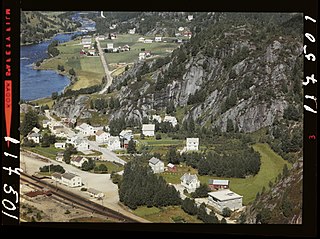
Storekvina is a village in Kvinesdal municipality in Vest-Agder county, Norway. The village is located on the shore of the river Kvina, about 7 kilometres (4.3 mi) north of the village of Liknes. The village had a population of 323 in 2015.

Fjotland is a former municipality in Vest-Agder county, Norway. The 600-square-kilometre (230 sq mi) municipality existed from 1838 until 1841 and again from 1858 until its dissolution in 1963. The administrative centre was the village of Fjotland where Fjotland Church is located. The municipality covered the northern part of the Kvinesdalen valley in the present-day municipality of Kvinesdal.
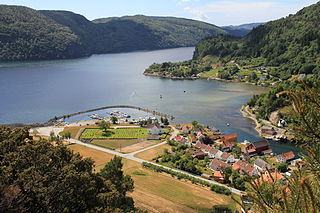
Feda is a former municipality in Vest-Agder county, Norway. The 66-square-kilometre (25 sq mi) municipality existed from 1900 until 1963. The administrative centre was the village of Feda where the Feda Church is located. Feda encompassed the far southern tip of the present-day municipality of Kvinesdal. It surrounded both sides of the 13-kilometre (8.1 mi) long Fedafjorden and the surrounding valleys.

Fjotland Church is a parish church in Kvinesdal municipality in Vest-Agder county, Norway. It is located in the village of Fjotland on the northeastern shore of the lake Fjotlandsvatnet. The church is part of the Fjotland parish in the Lister deanery in the Diocese of Agder og Telemark. The white, wooden church was built in 1836 using plans by the architect Hans Linstow. The church seats about 420 people.

Netlandsnes Chapel is a parish church in Kvinesdal municipality in Vest-Agder county, Norway. It is located in the village of Netland along the river Kvina, about 20 kilometres (12 mi) northwest of Fjotland. The church is part of the Fjotland parish in the Lister deanery in the Diocese of Agder og Telemark. The white, wooden chapel was built in 1886 by the architect H.A. Fedde. The chapel seats about 100 people.

Mandal is the administrative centre of Mandal municipality in Vest-Agder county, Norway. It is the second largest town by population in Vest-Agder county after Kristiansand and the fourth largest town in the Sørlandet/Agder region. The town is located at the mouth of the river Mandalselva at the southern end of the Mandalen valley. The 6.32-square-kilometre (1,560-acre) town has a population (2015) of 10,725 which gives the town a population density of 1,697 inhabitants per square kilometre (4,400/sq mi).



